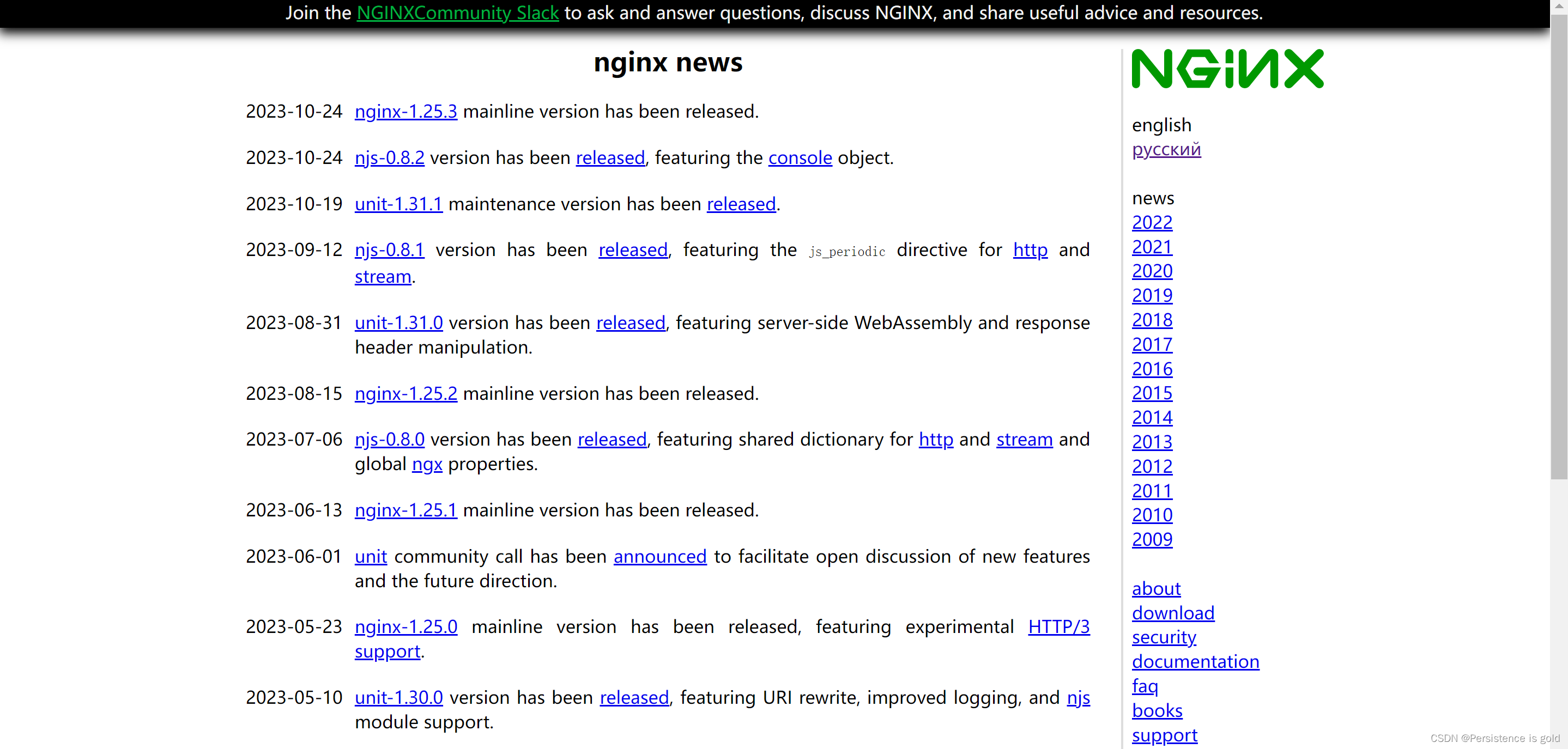thingsboard前端缓存--nginx
thingsboard+nginx
thingsboard部署到阿里云服务器之后,由于登录界面要发送的文件很大,并且服务器的带宽目前有限,因此配置一个nginx,进行前端页面的一些缓存,参考了https://qianchenzhumeng.github.io/posts/Nginx%E5%8F%8D%E5%90%91%E4%BB%A3%E7%90%86thingsboard%E5%B9%B6%E7%BC%93%E5%AD%98%E9%9D%99%E6%80%81%E6%96%87%E4%BB%B6/
这篇文章,特此表明。
也观看了狂神说study NGINX B站视频进行学习
目前实现服务器域名直接访问,不用从8080端口访问,但是目前首次(浏览器无缓存)访问需要一分钟左右,后续登录几秒完成。
1.访问nginx官网进行下载
https://nginx.org/

点击右侧download查看所有历史版本,下载自己想要的版本。

移入linux服务器root目录下,
1、解压
tar -zxvf XXX(nginx压缩包)
2、cd进入解压后的压缩包,运行./configure,执行自动配置
3、执行make
4、执行make install
cd /usr/local/nginx/sbin/
./nginx 启动
./nginx -s stop 停止
./nginx -s quit 安全退出
./nginx -s reload 重新加载配置文件
ps aux|grep nginx 查看nginx进程
访问80端口若成功,则没问题,阿里云服务器80端口一般已经默认开放了,不过如果启动后还是访问失败可以检查,https是443端口
服务器防火墙检查命令:
开启
service firewalld start
重启
service firewalld restart
关闭
service firewalld stop
查看防火墙规则
firewall-cmd --list-all
查询端口是否开放
firewall-cmd --query-port=8080/tcp
开放80端口
firewall-cmd --permanent --add-port=80/tcp
移除端口
firewall-cmd --permanent --remove-port=8080/tcp
#重启防火墙(修改配置后要重启防火墙)
firewall-cmd --reload
参数解释
1、firwall-cmd:是Linux提供的操作firewall的一个工具;
2、–permanent:表示设置为持久;
3、–add-port:标识添加的端口;
在/usr/local/nginx下找到conf配置文件夹下的nginx.conf配置文件
nginx.conf内容
#user nobody;
worker_processes 1;
#error_log logs/error.log;
#error_log logs/error.log notice;
#error_log logs/error.log info;
#pid logs/nginx.pid;
events {
worker_connections 1024;
}
http {
include mime.types;
default_type application/octet-stream;
#log_format main '$remote_addr - $remote_user [$time_local] "$request" '
# '$status $body_bytes_sent "$http_referer" '
# '"$http_user_agent" "$http_x_forwarded_for"';
#access_log logs/access.log main;
sendfile on;
#tcp_nopush on;
#keepalive_timeout 0;
keepalive_timeout 65;
#gzip on;
proxy_cache_path /cache/nginx/ levels=1:2 keys_zone=STATIC:50m max_size=2G inactive=365d;
server {
listen 80;
listen [::]:80;
server_name localhost;
#charset koi8-r;
#access_log logs/host.access.log main;
location ~* \.(jpg|jpeg|png|gif|ico|css|js|woff2)$ {
proxy_cache STATIC;
proxy_pass http://localhost:8080;
proxy_set_header Host $host;
proxy_cache_valid 200 1d;
proxy_cache_use_stale error timeout invalid_header updating
http_500 http_502 http_503 http_504;
proxy_ignore_headers X-Accel-Expires Expires Cache-Control Set-Cookie;
proxy_hide_header Pragma;
expires 365d;
}
location / {
proxy_pass http://localhost:8080/;
proxy_http_version 1.1;
proxy_set_header Upgrade $http_upgrade;
proxy_set_header Connection "upgrade";
proxy_set_header Host $host;
}
#error_page 404 /404.html;
# redirect server error pages to the static page /50x.html
#
error_page 500 502 503 504 /50x.html;
location = /50x.html {
root html;
}
# proxy the PHP scripts to Apache listening on 127.0.0.1:80
#
#location ~ \.php$ {
# proxy_pass http://127.0.0.1;
#}
# pass the PHP scripts to FastCGI server listening on 127.0.0.1:9000
#
#location ~ \.php$ {
# root html;
# fastcgi_pass 127.0.0.1:9000;
# fastcgi_index index.php;
# fastcgi_param SCRIPT_FILENAME /scripts$fastcgi_script_name;
# include fastcgi_params;
#}
# deny access to .htaccess files, if Apache's document root
# concurs with nginx's one
#
#location ~ /\.ht {
# deny all;
#}
}
# another virtual host using mix of IP-, name-, and port-based configuration
#
#server {
# listen 8000;
# listen somename:8080;
# server_name somename alias another.alias;
# location / {
# root html;
# index index.html index.htm;
# }
#}
# HTTPS server
#
#server {
# listen 443 ssl;
# server_name localhost;
# ssl_certificate cert.pem;
# ssl_certificate_key cert.key;
# ssl_session_cache shared:SSL:1m;
# ssl_session_timeout 5m;
# ssl_ciphers HIGH:!aNULL:!MD5;
# ssl_prefer_server_ciphers on;
# location / {
# root html;
# index index.html index.htm;
# }
#}
}
执行
sudo /usr/local/nginx/sbin/nginx -s reload
重载配置文件,nginx支持热部署,一般不用重启
本文来自互联网用户投稿,该文观点仅代表作者本人,不代表本站立场。本站仅提供信息存储空间服务,不拥有所有权,不承担相关法律责任。 如若内容造成侵权/违法违规/事实不符,请联系我的编程经验分享网邮箱:chenni525@qq.com进行投诉反馈,一经查实,立即删除!
- Python教程
- 深入理解 MySQL 中的 HAVING 关键字和聚合函数
- Qt之QChar编码(1)
- MyBatis入门基础篇
- 用Python脚本实现FFmpeg批量转换
- Java IO学习和总结(超详细)
- U盘启动安装win11遇到缺少计算机所需的介质驱动程序问题
- 网络工具之zenmap的安装和使用
- PCB设计规范及技巧顺口溜100句
- 【网络】网络层协议ARP和IP协议转发流程
- 如何使用 Typora 进行效率写作
- 阿里云日志表盘配置-图上展示想要的名称
- 【流复制环境PostgreSQL-14.1到PostgreSQL-16.1大版本升级】
- 论文阅读《Parameterized Cost Volume for Stereo Matching》
- GT304L电容式4键触摸芯片-超强抗干扰、低功耗